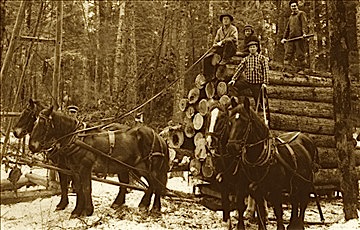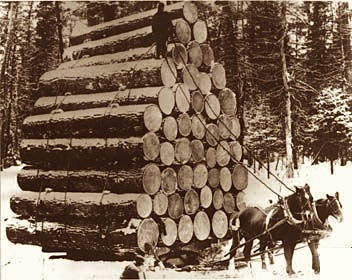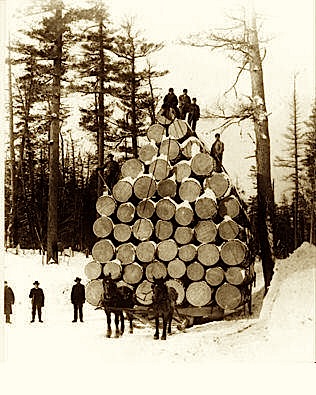submitted by Consulting Forester Tom Vorac
plus "How To Sell Timber on Your Property" (at the bottom)
by Mike Watson, Illinois Conservation Police Officer
For many tree growers, timber sales are made only once or maybe twice in their entire lifetime. It may take twenty or thirty years growing a crop only to lose much of its value because of one or two mistakes at the time of sale. Mistakes in selling timber can cost dearly.

Improper preparation and a poor marketing program can guarantee less than adequate compensation and can lead to headaches after the sale. No step in growing trees is more important than the sale of timber. You cannot spend too much time studying how to do it. If you really expect to get the greatest benefit from the sale of your trees, you need to take time to learn how to do it. Take a look at the following “you should's “when selling timber.
YOU SHOULD SEEK PROFESSIONAL ASSISTANCE!
Selling timber is really not a good do-it-yourself project. You know the value of a doctor or lawyer when it comes to their specific areas of knowledge. Consider a forester in the same light. Price quotes alone can become very confusing because timber may be bought in various units called cords, pounds, tons, board feet, and cubic feet. Unless the trees are marked so that each buyer is looking and bidding on the same trees, comparing bids can be like comparing apples and oranges. Selling timber requires expert advice as to what trees to cut, how they should be harvested, and what they are worth. At the very least, have a forester review your sale proposal.
Private consulting foresters handle sales for a living. They usually offer a wide range of specialized services, including comprehensive timber sales assistance, on a fee basis. Fees vary so you should understand what such a service will cost and how that may influence the sale. Many landowners find this expense more than offset by the higher selling price consultants often obtain for their timber. Studies have shown that people who sell timber using a professional forester’s help get up to 50 percent more for their trees. They probably sleep better at night as well.
Other objectives for ownership and management, such as recreation, wildlife and aesthetics should be considered before the sale. A forester who has a perspective of past sales can assure a much smoother sale and harvesting operation and avoid problems that may affect a forest owner's other objectives. Get professional advice.
There is a directory of consulting foresters that are both listed by the Illinois Extension Forester and are members of the Illinois Forestry Association HERE. This directory describes these individuals' qualifications, services, professional affiliations, and geographic areas of operation.
YOU SHOULD STUDY BEFORE ATTEMPTING A POTENTIAL SALE!
Timber owners should have some idea of what kind of timber they have to sell and the associated volumes. A forester can inventory timber and provide an estimate of volumes available for harvest. Potential buyers are more likely to be interested if they know what kind and how much timber is being offered for sale. This report can then be used to estimate a fair price you can expect for your sale.

Timing is important in getting the best price for wood. The best time to sell, obviously, is when demand for timber is up and prices are at a peak. This is easier said than done but you do need to be aware of current stumpage prices and market conditions in your particular local market.
With the exception of a specific disaster (from pests, weather, fire), you should not be rushed into a sale. Trees, unlike other farm products, can be stored on the stump during poor marketing conditions. One constant that history confirms is that timber values eventually go up.
Use the following "know" factors when sizing up your sale:
- Know the demand for and type of product you grow: The best prices are paid when demand is high and demand may differ as the potential product differs.
- Know the species for sale: Some tree species command higher prices than others. This is due to high demand or limited quantities of some species, or their special qualities.
- Know the quality of timber: Quality affects timber values just as it does any other product.
- Know the volume for sale: Logging requires the use of heavy equipment and numbers of men and large costs associated with this. Larger volumes for sale generally equate to higher stumpage prices because of the greater logging efficiency and reduced costs.
- Know distance from market: Transportation of forest products is expensive. Local mills should be able to pay higher prices for your products than more distant mills.
- Know size of trees: Generally, the larger trees bring the best prices. Large sawlogs and poles are worth more than small ones.
YOU SHOULD MAKE PREPARATION FOR THE POTENTIAL SALE!
First, you should identify prospective buyers. It would benefit you to prepare a comprehensive list of buyers for your area. Your IDNR district forester can provide a list of buyers. The consulting forester that you hire to assist in the sale can also provide a list of buyers and can act as an agent to solicit bids.
It may also be important to know what the buyer wants in terms of product. However, for the price of a postage stamp, you might simply send a bid invitation to all buyers within your determined procurement region.
Medium to large tracts of timber should be sold for a lump sum and on a bid basis. A sealed bid system should be used and generally results in higher selling prices as opposed to other sales methods. Bid invitations should be simple but informative and include the following:
- date, time, and location of the bid opening
- terms for payment
- number of trees by species, and volume (timber volume summary)
- location map indicating property boundaries and areas with the sale trees
- bid form
- information about the deposit/performance bond
- statement of seller's rights to reject bids
- notice of a "show-me" tour of sale area
 offer. A tour or "show-me" meeting on the timber sale allows all interested buyers to check the volume and quality of the timber and to estimate their logging costs. They should also be allowed to inspect and keep a copy of the contract or agreement you attach to the sale.
offer. A tour or "show-me" meeting on the timber sale allows all interested buyers to check the volume and quality of the timber and to estimate their logging costs. They should also be allowed to inspect and keep a copy of the contract or agreement you attach to the sale.After the sale has been shown and all bids have been received, you should notify the highest acceptable bidder and arrange to negotiate and execute a written contract. Any deposit or performance bond agreed upon should be collected. Copies of the contract should be prepared for both buyer and seller.
Regardless of the size of the timber sale, a written contract prevents misunderstanding and protects both the buyer and seller. The contract should contain, at a minimum, the following:
- a legal description of the timber sale area or property
- the selling price
- terms of payment, including Illinois' 4% harvest fee to be collected
- the number of trees and associated volume that will be cut
- time allowed to cut and remove timber
- adherence to all forestry Best Management Practices
YOU SHOULD INSPECT AND RETIRE THE SALE!
To make sure terms of the timber sale contract are being met, you or your agent should inspect the operation periodically. It is best looked at several times during the harvest and finally upon completion. A satisfactory final inspection would initiate the full return of the deposit, if any, to the buyer.
Steps should be taken immediately after harvest to protect the land from erosion and to insure the productivity of this future forest. Roads, skid-trails, and logging decks should be secured and reshaped if necessary. Bare areas should be seeded in grass to prevent erosion and provide food for wildlife.
If you have read this far and are feeling overwhelmed, go back to the first “should” and use it! Proper preparation and a good marketing program can guarantee adequate compensation both in value of the sale and condition of your property when the harvest is completed.
"How To Sell Timber on Your Property"
by Mike Watson, Illinois Conservation Police Officer
I have had my job with the Conservation Police for 25 years now and I have always considered it a dream position. I love my work and over the years my interaction with the residents of Montgomery and the surrounding counties have been enjoyable...well, almost all of them have.
The latter is what I want to discuss in this column. Over my career I have had many encounters with the public regarding timber complaints. My department is responsible for enforcing the timber code. I want all who read this to spread the word. This is valuable information that could save you heartache and money.
If you or a family member is contemplating having timber harvested from a property there are many important factors to consider. Selling timber from your property is like any other transaction where major money will change hands. I realize I may have grabbed your attention by using the term “major money” and I did this for a reason. Hardwood timber is worth a lot of money. It is a renewable resource that takes many years to appreciate. Your timber should be viewed as an investment and should be handled as such. Unfortunately some elderly residents I have encountered do not view their timber property as their IRA or other retirement accounts. Often times they view it as just some trees on their property that someone is offering them a few bucks to remove and are unaware of its value.
Mature oak and walnut trees are very valuable depending on how they grade out at a timber mill. When you are driving down the highway and you see a timber truck, I want everyone to understand the possible dollars on those trailers. Depending on the quality of the logs thousands of dollars are being hauled to a nearby sawmill. Therefore, careful thought should be given to who you allow to come upon your property and remove these trees.
I am going to list a few things I want you to do before agreeing on a timber deal.
1. Get several bids. (Would you take the first and only bid when purchasing a car, building a house or any other major transaction? Of course not.) Have the trees that are to be harvested marked so you know exactly what you are being paid for. A forester can do this to manage your timber or the buyer can mark what he intends to take. Either way you have a set standard to base the bids on and an idea of what the area will look like after the harvest.
2. Ask questions from a prospective timber buyer. Ask for references and if they are hesitant to give you a name of someone they have done a job for, I would advise you to look elsewhere. Call those references and check on the work of the buyer. Ask to see a copy of their buyers license.
3. Before signing a contract, understand it. (The devils in the details in matters such as cleanup, top removal, future erosion problems, etc…). Spending a few hundred dollars for an attorney to write or review a contract can be money well spent. A contract should address at a minimum the following: Legal description of timber to be harvested, Sale price and payment method, 4% harvest fees, Penalties for breach of contract and damage to remaining timber or crops, Liability coverage, Effective date, Termination date, Title guarantee, Buyers rights, Buyers access to property, Restriction on harvest due to wet weather and Witnessed signature of buyer and seller.
4. Understand what you are going to be paid and when payment will be made. The best is to have all money paid up front before the timber is ever cut. Make sure the contract states if payment is not received as agreed to the contract is immediately terminated. This is very important! If you agree to payment as the timber is harvested then make sure they are required to show you all mill receipts and deliver a check weekly. You must pay attention to how much timber is removed and when to have an accurate accounting. I have received many calls about this type of payment agreement when payment is not received and landowners allow weeks of excuses for non-payment until eventually the timber is gone without any pay. If the timber cutter is not living up to his end of the bargain put a stop to the timber removal immediately! If the timber cutter will not agree to this, show him the door!! Also find out exactly where the cutter will be taking your logs. If you know where they are being sold you can double check on the saw mills paperwork to make sure you are not being cheated.
5. NEVER MAKE A VERBAL CONTRACT WITH A TIMBER CUTTER! This sounds like common sense doesn’t it? You would not believe the number of trusting folks out there and less scrupulous buyers will take advantage of those individuals.
6. Once a contract has been signed often times there is little I can do to help remedy the situation. That contract is a binding legal document and a landowner should think about that before signing on the dotted line. Many of the disputes I have investigated over the years involve the landowner being forced to take their case to civil court. In these instances it is the landowner’s responsibility to make his or her case before the court.
7. A timber tax fee must be paid, which is deducted from your payment and must be submitted by the timber cutter, to the IDNR Forestry Division on a quarterly basis. Again, details that should be in the contract.
8. Explain and show or mark the boundaries to your timber cutter before the job is started. Be a good neighbor and notify surrounding landowners before the harvest. If you are not sure of the property lines get together with your neighbor before the job is started. When adjoining timbers between landowners exist it’s your responsibility to make sure only your trees are cut. If I investigate a wrongful tree cutting complaint I will determine who is at fault. However, in the end you or the timber cutter will be responsible for those trees illegally removed from a neighbor’s property. Often a survey may be needed if a dispute arises.
9. Contact your local conservation officer and the Better Business Bureau to see if the timber cutters who you are considering have had complaints on them. I have dealt with elderly widows in the past who have basically given thousands of dollars away because they did not know who they were dealing with. More than likely we have had interaction with these buyers and could provide valuable knowledge on the subject. I cannot legally tell who you should do business with but our officers have a working knowledge of those timber cutters who have a less than honorable history.
I decided to write this column to make sure the citizens I am entrusted to protect are educated. I do not want you to find yourself in a no-win situation that could have been avoided if only a little homework had been done.
In closing I don’t want you to think all timber people are out to steal from the unsuspecting. However, I want you to be vigilant against those who are bad and will take advantage of you.

